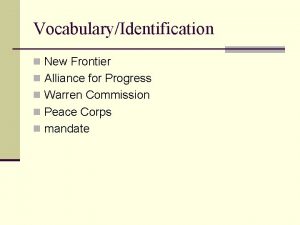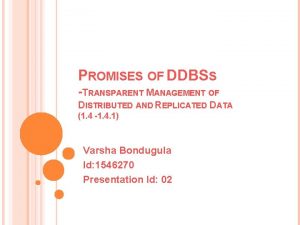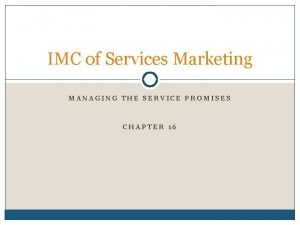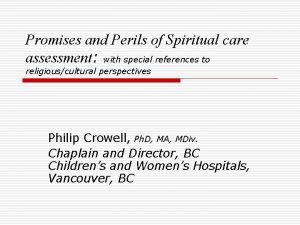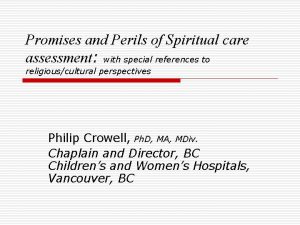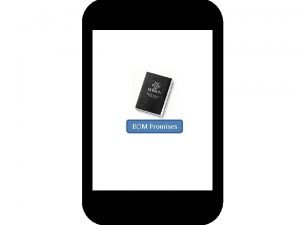Promises and Perils of Machine Learning A Realworld






















- Slides: 22

Promises and Perils of Machine Learning: A Real-world Evidence Fable Wednesday, August 30, 2017 ICPE Montreal

Symposium Agenda • Introduction and overview of approaches – Mary Beth Ritchey • Two examples – Mary Anthony – Niklas Noren • Methodological considerations of concept development – Michele Jonsson Funk • Framework for review and comment – Nabarun Dasgupta 2

Overview of the Continuum of Approaches Mary Beth Ritchey, Ph. D Principal Epidemiologist for Medical Devices, RTI Health Solutions

Disclosures - Ritchey • No specific funding was received for this project. • The following personal or financial relationships relevant to this presentation existed during the past 12 months: – Employment by RTI Health Solutions, a research institute that performs contracted services for pharmaceutical and medical device companies 4

Big Data in Health Care Sources: http: //www. mckinsey. com/industries/healthcare-systems-and-services/our-insights/the-big-data-revolution-in-us-health-care ; https: //www. forbes. com/sites/bernardmarr/2015/04/21/how-big-data-is-changing-healthcare/#723 a 8 e 592873 ; http: //www. clinical-innovation. com/topics/analytics-quality/jama-opportunitiesand-challenges-big-data; http: //content. healthaffairs. org/content/33/7/1123. abstract 5

Caveats with Big Data in Health Care Sources: http: //catalyst. nejm. org/real-world-results-digital-health-products/ ; http: //www. bmj. com/content/358/bmj. j 3275 ; https: //healthitanalytics. com/news/top-10 -challenges-of-big-dataanalytics-in-healthcare; http: //www. nejm. org/doi/full/10. 1056/NEJMp 1606181 6

Barriers to Using “Big Data” • • • Patient protection Data quality Cost (monetary, time, resources) Transparency Disparate rules across stakeholders Challenge for traditional peer review and publications Where to start? List adapted from source: http: //www. nehi. net/writable/publication_files/file/rwe_issue_brief_final. pdf 7

Data Sources • Data are generated and collected from multiple sources, aggregated and shared across health care system • In medical product epidemiology and vigilance, we use data sources collected for other purposes in order to assess utilization, safety, and effectiveness Source: http: //www. nehi. net/writable/publication_files/file/rwe_issue_brief_final. pdf 8

Types of Data Structured Data Unstructured Data Characteristics • Pre-defined ontology • Easy to search • Not pre-defined – may be text, image, sound, video • Difficult to search Examples • • • ICD-10 -CM Read LOINC ATC Med. DRA Clinical notes Radiographs Social media Mobile health data Adapted from source: http: //www. datamation. com/big-data/structured-vs-unstructured-data. html 9

Continuum of Approaches Code lists Structured Information extraction Text/Audio /Visual Analytics Predictive Analytics Unsupervised Learning Structured + Unstructured Adapted from source: Gandomi A, et al. Beyond the hype: big data concepts, methods, and analytics. Int J Information Mgmt. 2015; 35: 137 -44. 10

Years Studying Validity of Structured Data Source: https: //www. ncbi. nlm. nih. gov/pmc/articles/PMC 3207195/pdf/hesr 0046 -1610. pdf 11

How can we use unstructured data? 12

Focus on Research Question • What do I want to learn? – Exposures, outcomes, covariates – Cross-section vs longitudinal data • When does this research need to be addressed? – Timeframe within study – Timing of results • Who wants to know? • Why is study needed? • Where are data coming from? 13

Example Lifestyle Factors New T 2 DM Drug T 2 DM = type 2 diabetes mellitus. 14 Cardiovascular Outcomes

Continuum of Approaches • Ignore the variable for analyses • Use the data within the data source, despite misclassification – Sensitivity analysis • Use proxy within the data source • Use information from an alternative source – External adjustment • Integrate data from an alternative source 15

Where can we find needed data? • Within data source used to address research question • National surveys • Published literature • Clinical notes • m. Health apps • Social media Source: Weber GM, et al. , Finding the missing link for big biomedical data. JAMA 2014; 311(24): 2479 -80. 16

Continuum of Approaches • Ignore the variable for analyses • Use the data within the data source, despite misclassification – Sensitivity analysis • Use proxy within the data source • Use information from an alternative source – External adjustment • Integrate data from an alternative source 17

How do we use the data? 18

Structured Data – Code List Development • Generate list of terms/constructs for which codes will be needed – Review with key study team members – achieve consensus • Generate list of codes for each term (for each coding system) – Review with key study team members – achieve consensus • Incorporate codes into an algorithm • Validate algorithm (and assess reliability of algorithm across coding systems) • Update algorithm each time terminology changes • Anticipate changes in practice over time that will lead to changes in underlying data entry for some codes Source: Quan H, et al. , Coding algorithms for defining comorbidities in ICD-9 -CM and ICD-10 administrative data. Med Care. 2005; 43: 1130 -39. 19

Unstructured Data – Natural Language Processing Source: Liao KP. Development of phenotype algorithms using electronic medical records and incorporating natural language processing. BMJ. 2015; 350: h 1885. 20

Unstructured Data – Natural Language Processing • • Extract concepts from unstructured data Develop algorithm incorporating structured and unstructured data Curate to improve algorithm performance Validate algorithm (stratified sampling or iterative approach) Algorithm learning may be “supervised” or “unsupervised” Source: Liao KP. Development of phenotype algorithms using electronic medical records and incorporating natural language processing. BMJ. 2015; 350: h 1885. ; Upadhyaya SG, et al. Automated diabetes case identification using electronic health record data at a tertiary care facility. Mayo Clin Proc Inn Qual Out. 2017; 1(1): 100 -110. 21

Let’s look at some examples… 22
 Realworld systems
Realworld systems Nitcar
Nitcar Direct quotation examples
Direct quotation examples Inductive and analytical learning in machine learning
Inductive and analytical learning in machine learning Inductive analytical approach to learning
Inductive analytical approach to learning Eager vs lazy
Eager vs lazy Concept learning task in machine learning
Concept learning task in machine learning Analytical learning in machine learning
Analytical learning in machine learning Pac learning model in machine learning
Pac learning model in machine learning Pac learning model in machine learning
Pac learning model in machine learning Instance based learning in machine learning
Instance based learning in machine learning Inductive learning machine learning
Inductive learning machine learning First order rule learning in machine learning
First order rule learning in machine learning Cmu machine learning
Cmu machine learning Cuadro comparativo de e-learning
Cuadro comparativo de e-learning Frontiern
Frontiern Who can baptize
Who can baptize Solemn promises
Solemn promises Promises of distributed database system
Promises of distributed database system Managing service promises
Managing service promises Old testament promises
Old testament promises Managing service promises
Managing service promises Transitory service intensifiers
Transitory service intensifiers















